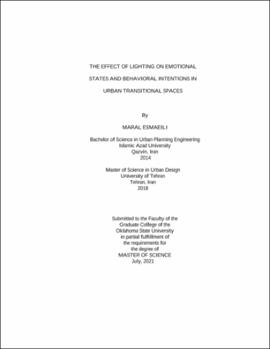| dc.contributor.advisor | Carter, Heather | |
| dc.contributor.author | Esmaeili, Maral | |
| dc.date.accessioned | 2022-01-21T19:33:41Z | |
| dc.date.available | 2022-01-21T19:33:41Z | |
| dc.date.issued | 2021-07 | |
| dc.identifier.uri | https://hdl.handle.net/11244/333795 | |
| dc.description.abstract | Extending precedent studies on ambient lighting and its effects on people's perceptions, this study explored the influence of lighting on the users' emotional states in the urban transitional space at nighttime. The investigation of stimulus factors and their effects on individuals' emotional state (arousal/pleasure) and behavioral intentions (avoidance/approach) as positive engagements can provide the key to what makes urban transitional spaces a final destination in the public realm. The main question was the extent to which light intensity and the color temperature of lighting influence people's emotional states and behavioral responses in these urban transitional spaces. | |
| dc.description.abstract | The current study employed technology as a mechanism to represent and manipulate existing environmental lighting conditions. A 2 (warm lighting vs. cool lighting) x 2 (dim lighting vs. bright lighting) factorial experiment was conducted. All digital perspectives were initiated into four different lighting conditions: (a) bright lighting with warm color, (b) dim lighting with warm color, (c) bright lighting with cool color, and (d) dim lighting with cool color. A Rico Theta S camera and Cupix software were used to capture and develop the environment's spherical tour, and Adobe Photoshop was employed to manipulate the lighting condition of each scenario. | |
| dc.description.abstract | Participants were randomly assigned to one of the four lighting conditions and navigated through the specific spherical image (360 degrees). At the end of the experiment, participants were asked to rate their feelings and intentions by completing a 5-point Likert scale questionnaire. This method allows designers to compensate for other factors in the surroundings and minimize external influences that might impact the users' emotional states or decision-making. It was predicted that both light intensity and the color temperature of light would influence individuals' perceptions and psychological responses. Results showed, there is a positive relationship between the CCT of light and the participants' rating of the levels of pleasure and arousal as well as how individuals' approach or avoid an urban transitional space because of their lighting conditions. The current study contributes to a better understanding of lighting characteristics on peoples' willingness to approach and avoid urban transitional spaces. | |
| dc.format | application/pdf | |
| dc.language | en_US | |
| dc.rights | Copyright is held by the author who has granted the Oklahoma State University Library the non-exclusive right to share this material in its institutional repository. Contact Digital Library Services at lib-dls@okstate.edu or 405-744-9161 for the permission policy on the use, reproduction or distribution of this material. | |
| dc.title | Effect of lighting on emotional states and behavioral intentions in urban transitional spaces | |
| dc.contributor.committeeMember | Chandrasekera, Tilanka | |
| dc.contributor.committeeMember | Jayadas, Aditya | |
| osu.filename | Esmaeili_okstate_0664M_17297.pdf | |
| osu.accesstype | Open Access | |
| dc.type.genre | Thesis | |
| dc.type.material | Text | |
| dc.subject.keywords | behavioral intentions | |
| dc.subject.keywords | emotional states | |
| dc.subject.keywords | lighting condition | |
| dc.subject.keywords | spherical image | |
| dc.subject.keywords | urban transitional space | |
| thesis.degree.discipline | Design, Housing and Merchandising | |
| thesis.degree.grantor | Oklahoma State University | |
